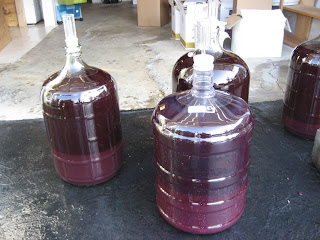A couple months ago I entered one of our wines in the Orange County Fair. We don't live anywhere near Orange County, but the
Orange County Wine Society hosts a statewide amateur winemaking contest in conjunction with their county fair. We heard that as a result you get 4 judges to taste and evaluate your wine, so we went for it and entered one of our 2007 Cabernet Sauvignons (Leach Vineyards).
To our surprise, we got a gold ribbon in the mail the other day. Yeay! Given that this is from grapes we didn't grow, kudos really go to Don, the grower we bought these grapes from who lives just a few miles down the road.
Some specifics from the judges:
- We got positive reviews on the basics: clarity/appearance, color, acidity, balance
- One judge sensed that we got a little green/vegetal smell and taste, but indicated it's 'not too bad'
- Another judge thought that the body was slightly thin, and that the finish tapers a bit too quickly
- The most laugh-inducing comment: "Skillfully made"
Specific words the judges used to describe the wine:
Plum, black cherry, nice spicy characteristic, balanced fruit & oak















































